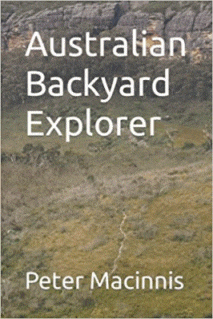
Australian Backyard Explorer
Australian Backyard Explorer
Peter Macinnis
Amazon, 2021
180pp., pbk., RRP $A40.00
9798481595085
When your students are introduced to those who opened up this country to others, do their investigations focus on those of the 18th and 19th centuries who trekked into areas they thought were unknown , in search of whatever they could find to make them (or their sponsors) more money?
Or do they go beyond the usual familiar names and discover the indigenous people who first trod the “native roads” and guided those following? Do they meet the women and the teenagers who also forged paths? Do they consider how those people whose names we know found their way, collected food and water, found shelter, coped with the weather, measured distance and all the other issues and problems that needed to be addressed as they made their way into unknown and inhospitable territory?
Originally published by the National Library of Australia in 2009, Australian Backyard Explorer won the 2010 CBCA Eve Pownall Award for Information Books, this work combines history with science and technology to give readers an insight into who the ‘explorers’ of Australia were, what they did and how they did it. This is the 2021 updated version that takes the reader further as the author has delved deeper into the stories behind the stories, but like the original still has Peter’s gift for winkling out long-lost information and uncovering deep dark secrets that bring the people and the text to life. Chapters are arranged according to issues rather than specific people, beginning with “Who were the explorers?” and there are all sorts of devices to engage the reader including projects that they can undertake to test a theory or see how something works for themselves. (A list of these is provided for easier navigation.) There are also all the illustrations of the original from the vast collection of the National Library of Australia.
For example, Chapter 9 is devoted to staying alive and although Ernest Giles believed that this involved being able “to take, and make, an observation now and again, mend a watch, kill or cure a horse as the times may require, make a pack saddle, and understand something of astronomy, geology and mineralogy” we learn about how repairs were made; the disasters which befell expeditions and the need to stay calm and collected in their face; how to get help in a time long before personal safety beacons and mobile phones were invented; and how accidents and illnesses were treated without the aid of a helicopter and medivac team.
This unique approach means that students will really engage with this country’s past, will understand the courage and determination it took to travel beyond city limits and perhaps put themselves in the shoes of those who have gone before as they try to solve the problems for themselves. They will be active investigators rather than passive consumers of facts, figures, dates and distances. The imaginative teacher could devise an inquiry unit using any of the chapter headings as the exploratory question and then let the students have at it…
This is a must-have book to ensure that what can so often become ho-hum become engaging and exciting.